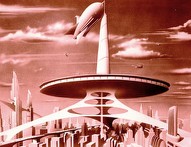Welcome to the RSS Search Engine Formerly Known as Roogle — I Give you Feedster !.
Welcome to the RSS Search Engine Formerly Known as Roogle — I Give you Feedster !
Well I've got two very good pieces of news for today. The first one is the new name: feedster.com. The site is up and working. Feel free to stop on by.
Logo help from Etation Media and I know about the swoosh…
Lots of great activity on the RSS front, which is definitely a good thing. I expect I'll be adding a link to Feedster on my blog in the next couple of days.


 Jeff sez, “A Web site of the futuristic illustrator Radebaugh. You'll recognize some of his illustrations as magazine covers from the 1930s through the 1950s. Our vision of the future was, in part, molded by these types of illustrations. One of my favorite films is The 5th Element where the art direction seems to come right from Radebaugh's brush.”
Jeff sez, “A Web site of the futuristic illustrator Radebaugh. You'll recognize some of his illustrations as magazine covers from the 1930s through the 1950s. Our vision of the future was, in part, molded by these types of illustrations. One of my favorite films is The 5th Element where the art direction seems to come right from Radebaugh's brush.”